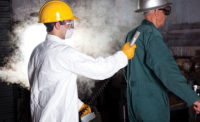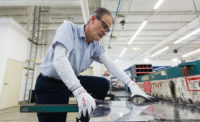Quit fumbling around: What you should know about instrument docking stations

A vast expanse of blue gradually fills the horizon as you drive to the beach for a day of fun in the sun with your family. Your young daughter can barely contain herself, and she bursts out of the car in a full sprint toward the waves — but you stop her. Now, she wiggles impatiently through your hands as you hold her down and slather SPF 30 (or more) over every exposed part of her body. She’ll understand someday, you tell yourself, and you see to it that you are adequately covered as well.
Life is full of habits that we’ve developed over time to make sure that we are leading the healthiest and safest life possible. You make sure that you use sunscreen when you go outside, make certain that everyone in your vehicle is wearing their seatbelts, and turn off electronics and lights before leaving the house, topped off by double-checking that you’ve locked the door. At first, these habits needed to be learned. Once we understood their importance, however, the proverbial light switch flipped, and we knew that the regular display of these behaviors could turn out to be advantageous.
Safety in the workplace
Healthy habits are also prevalent in the workplace. Hard hats, safety gloves, eye protection, air masks, and a slew of other safety regulations ensure that we make it home in one fully functional piece day after day. Some of these health and safety behaviors may be harder to pick up on than others, but once they are made into habit, they are understood to be no-nonsense ways of working to keep ourselves safe and sound. Gas detection is no exception. Many gas detection procedures require you to bump test before each use and calibrate at regular intervals to ensure that the instrument is functioning correctly. However, if you’re bump testing and calibrating manually, it can be tedious and frustrating, leaving a lot of room for human error. Many other safety precautions during your day have been simplified into an easy habit, so why not your gas detection?
Considering the ease of use and features that docking stations can provide, it’s a wonder that their use hasn’t become more widespread. Commonly, when prospective users are asked why their company has not yet integrated docking stations into their day-to-day gas detection routine, cost, IT issues and infrequently used instrumentation are among reported rationalizations against making the commitment. These types of responses are to be expected, although many naysayers may find that more times than not, these fears are quite easily addressed by their gas detection provider. It is also important to realize that there may be a deeper meaning to these reasons: sweet, blissful ignorance. A startling amount of could-be, would-be docking station users admitted that they do not use docking stations simply because they do not know enough about them to make an informed decision. This is a little disheartening, especially once you realize that docking stations are not necessarily the new kids on the gas detection block anymore. Their 15 years has earned them a strong niche within the market — one that deserves to be expanded. A focus on educating the mass market on the benefits of docking stations could be the solution.
Meet the docking station
Allow me to introduce (or re-introduce) you to the docking station. Docking stations automate the processes of bump testing, calibrating and data collection, ensuring consistency and accuracy. In many cases, you can also leave an instrument on a station to charge overnight. All workers need to do is connect the dock to power, put the instrument into its cradle, and let it do the rest. Many docking stations also provide data logging capabilities, collecting and organizing information such as bump and calibration pass/fails, alarms and peaks.
Docking stations provide peace of mind to both workers and management alike. Workers simply dock their instruments at the end of their shift and leave with the confidence that their instrument will be ready to go for them the next day, having undergone any necessary calibrations and testing. Since manual calibration and bump testing can sometimes be tricky, there is a lot of room for human error. For example, perhaps a worker is scheduled to work with an instrument that he or she is not overly familiar with. In this case, manual testing could be problematic. If the company were using docking stations, the worker would not have to worry about the logistics of the instrument — just set it in the dock and wait for the tests to be completed. Management can rely on docking stations to not only keep their workers safe, but their company as well. Many docks collect and organize instrument data each day, allowing for the information to be studied for safety accountability. Some docking stations are even able to connect to the Internet either through a company-owned server or via the cloud, where data can be organized using interactive dashboards. Docking stations also save companies money on calibration gas because of the controlled, consistent way in which gas is drawn to the instruments for testing. In addition, optional automatic calibration gas replenishment programs allow users to receive replacement cylinders before existing ones expire or become empty.
Docking stations take manual calibration and bump testing, a potential mess of fumbling with gas bottles, tubes, and instrument settings, into a simple and easily habituated maneuver. Much like remembering sunscreen, putting on a seatbelt, or donning a hard hat, docking an instrument is a learned behavior, but also an uncomplicated and extremely beneficial one. Healthy habits are an invaluable, yet underappreciated piece of our lives, and docking station usage has the potential to become one for the books for gas detection.
Looking for a reprint of this article?
From high-res PDFs to custom plaques, order your copy today!





